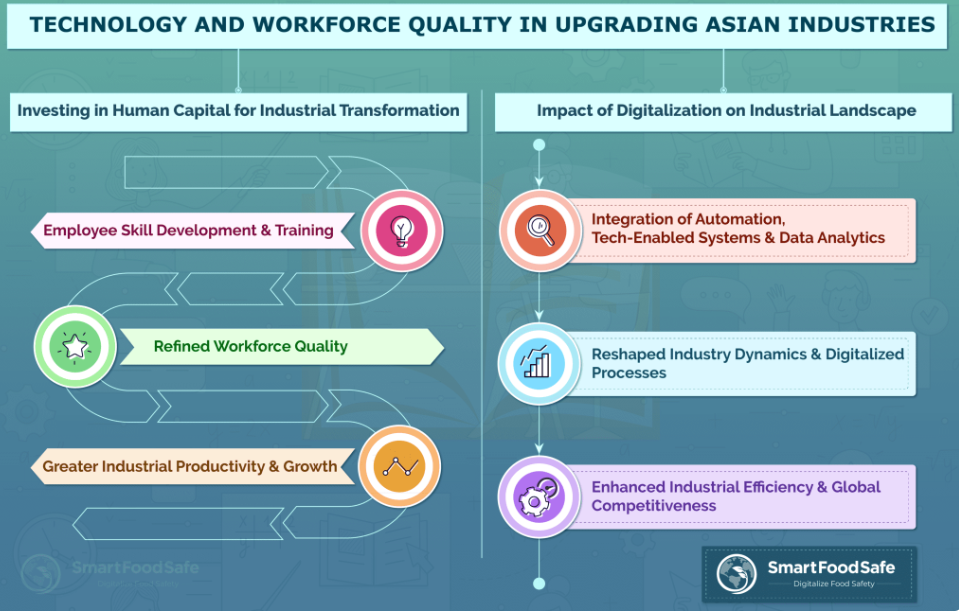
Did you know that a staggering 94% of employees expressed a willingness to remain with a company if it prioritized continuous learning? This revelation comes from LinkedIn’s 2018 Workplace Learning Report, underlining the significance of ongoing learning opportunities.
The rise of digital technology is reshaping the landscape of talent development. Traditional learning methods are undergoing a transformation, with online platforms, virtual classrooms, and interactive tools providing personalized and flexible learning experiences. This is where a robust learning management system (LMS) comes into play.
Over the past four decades, numerous Asian economies have undergone significant structural changes in output and employment systems. East Asian economies, including Japan and Southeast Asian countries, have experienced remarkable economic and industrial advancements. Meanwhile, India has aimed to boost manufacturing’s contribution to GDP and job creation, while the Philippines has sought to reverse a period of deindustrialization. The pivotal role of the industrial sector in Asian economies’ rapid growth highlights the importance of understanding the interplay between labor quality, digitalization, and industrial enhancement, all crucial for sustained economic development.
Investing in Human Capital for Industrial Transformation
The study “Unleashing the Potential of Labor Quality and Digitalization in Upgrading Asian Industrial Structures” sheds light on the intricate relationship between labor quality, digitalization, and industrial structure enhancement across diverse Asian countries.
The augmentation of human capital quality emerges as a pivotal factor in shaping the industrial structure, as revealed by the study. A strong positive correlation between labor quality and industrial framework advancement across different Asian nations was observed.
Given the diverse labor markets in these countries, strategic investments in human capital through education, skill development, and workforce training emerged as catalysts for enhancing industrial productivity and efficiency. Prioritizing the refinement of labor quality significantly contributes to overall industrial enhancement, supporting economic growth, investment attractiveness, and a conducive environment for advancement.
The study also emphasizes the favorable influence of digitalization on the evolution of the industrial landscape in Asian countries. This digital transformation stimulates industrial structure advancement, supported by robust institutional frameworks, comprehensive employment strategies, and robust research and development initiatives. This integration translates to increased productivity, operational efficiency, and innovative capabilities, bolstering these industries’ competitive positions globally.
Conclusion and Future Research
In pursuit of effective developmental strategies, each Asian country should evaluate its unique strengths and weaknesses in the context of digitalization. Addressing the digital divide in certain Central and South Asian nations requires concerted efforts to strengthen regional infrastructure. Drawing from the study’s insights, an effective approach for Asian industries involves combining digitalization and skill development through the adoption of an efficient Learning Management System (LMS).
Creating and Managing Content
The journey begins with content creation. Educators, trainers, or administrators design digital learning materials that are organized and uploaded to the LMS. Courses are made engaging through the inclusion of audio, video, presentations, interactive quizzes, and even virtual reality experiences.
User Management
LMS platforms allow administrators to manage user accounts. This involves creating new accounts, enrolling users in specific courses, assigning roles (such as student, instructor, or administrator), and setting access permissions.
Course Creation and Structure
Instructors or content creators utilize the LMS to design courses. A course typically comprises a sequence of modules or lessons. Within these modules, content is uploaded, objectives are set, and learning outcomes are defined. Assessments like quizzes or assignments can be incorporated to gauge learners’ progress.
Enrollment and Access
Learners are enrolled in courses by administrators or instructors. Upon enrollment, they gain access to the course materials and resources within the LMS. Some systems even allow self-enrollment, granting learners the freedom to choose and join courses independently.
Learning Delivery
Admins can share lessons with employees online and monitor their progress. Learners access course materials, which encompass videos, presentations, reading materials, interactive simulations, and more, via the LMS. They can study at their own pace, following the course structure set by the instructor. Assessments are completed, with the system automatically grading and recording performance.
Progress Tracking
Features for tracking progress enable oversight of learners’ advancement through the course. Advanced reporting systems provide managers with dashboards to monitor individual progress, simplifying compliance demonstration and audit preparedness.
Communication and Collaboration
LMS platforms often include communication tools such as discussion forums, chat, and messaging systems. These tools facilitate interaction between learners and instructors, allowing for discussions, questions, and clarifications.
Feedback and Reporting
Instructors can provide feedback on assignments and assessments through the LMS. Administrators and instructors can access detailed reports and analytics regarding learner progress, engagement, and performance. This data aids in refining courses and instructional strategies.
Certification and Completion
Completion of a training course results in a certificate and proof of competencies, enhancing one’s resume and professional profile. Notifications are sent to managers when learners complete courses.
In a world shaped by digitalization, Smart Training stands as a beacon of innovation, leveraging its capabilities to empower the workforce, drive industry transformation, and secure a prosperous future. Embrace the digital era and elevate your business with Smart Training – where learning meets digital empowerment.
Unlock Digital Potential: Smart Training's dynamic platform provides 24/7 access to top-notch training materials, eliminating geographical barriers and enabling seamless learning.
Tailored Learning Paths: It offers personalized courses aligned with individual strengths, weaknesses, and career goals, accelerating skill acquisition and boosting engagement.
Real-Time Progress Monitoring: Smart Training tracks employee progress in real-time, allowing timely interventions and adjustments to ensure consistent learning.
Engaging Learning: Through interactive multimedia tools, it creates immersive learning experiences, promoting critical thinking and adaptability.
Fostering Industry Transformation: By equipping your team with up-to-date skills, Smart Training positions your company as an industry leader, driving innovation.
Measurable ROI: With robust analytics, it quantifies training's impact on performance, turnover, and operational efficiency, ensuring a significant return on investment.
_1.png)